Human Resource Management Report: M&S Training Strategies
VerifiedAdded on 2019/12/28
|17
|5267
|108
Report
AI Summary
This report delves into the realm of Human Resource Management (HRM), focusing on training and development strategies within the context of a case study on Marks and Spencer (M&S). It begins by examining various learning styles, including Activist, Reflector, Theorist, and Pragmatist, and their impact on individual learning capabilities. The report then explores the role of learning curves and the importance of transferring learning to the workplace, highlighting both positive and negative transfer scenarios. Furthermore, it compares the training needs at different organizational levels (operational, middle management, and senior management) and evaluates the advantages and disadvantages of on-the-job and off-the-job training methods. The report also outlines a systematic approach to training for new employees. In addition, it proposes an evaluation plan using appropriate techniques and assesses the impact of training on employee performance and competency levels, including a review of the success of evaluation methods. Finally, the report examines the role of government in influencing training programs and discusses the development of the competency movement in both the public and private sectors, including an overview of UK government initiatives in human resource development training programs.
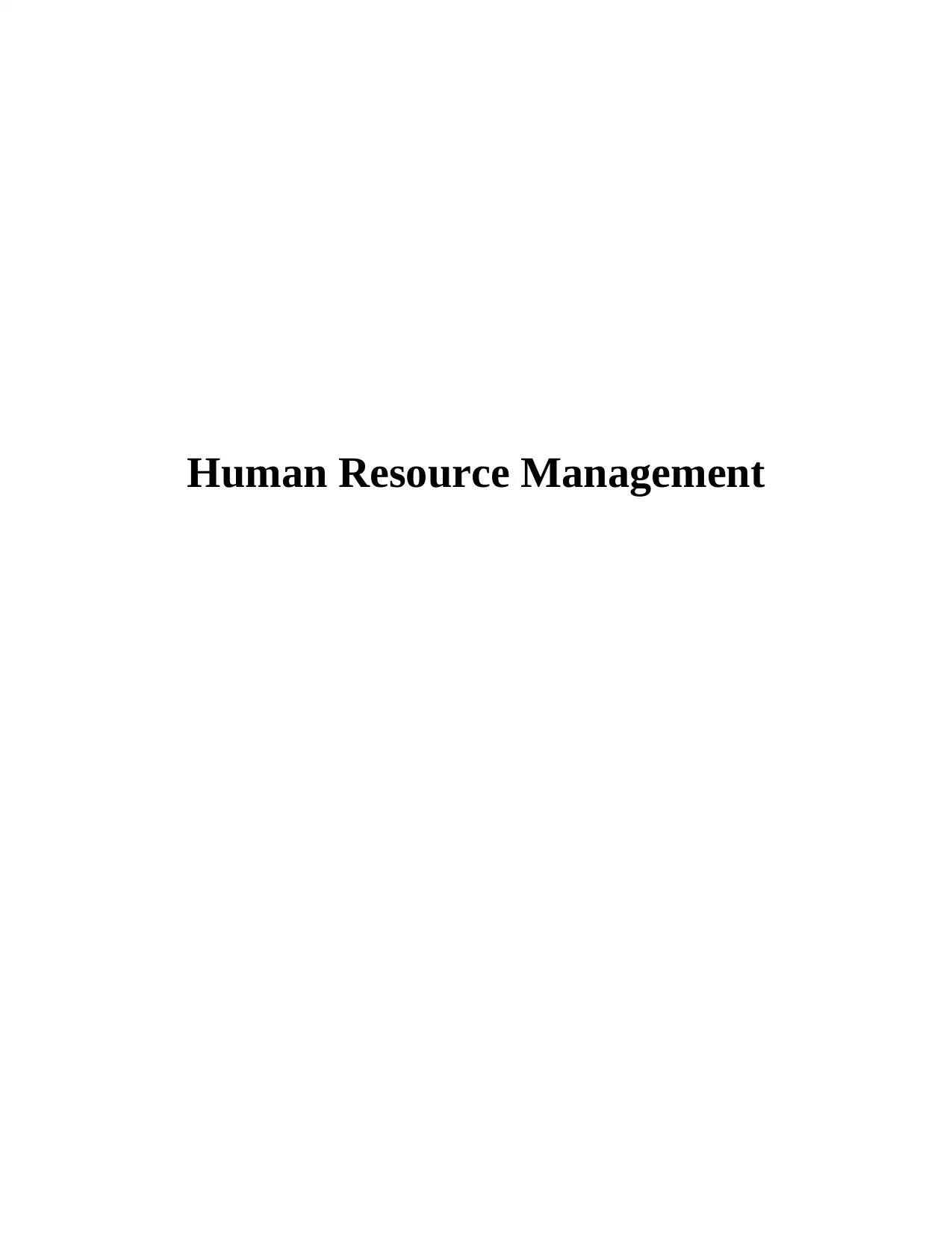
Human Resource Management
Paraphrase This Document
Need a fresh take? Get an instant paraphrase of this document with our AI Paraphraser
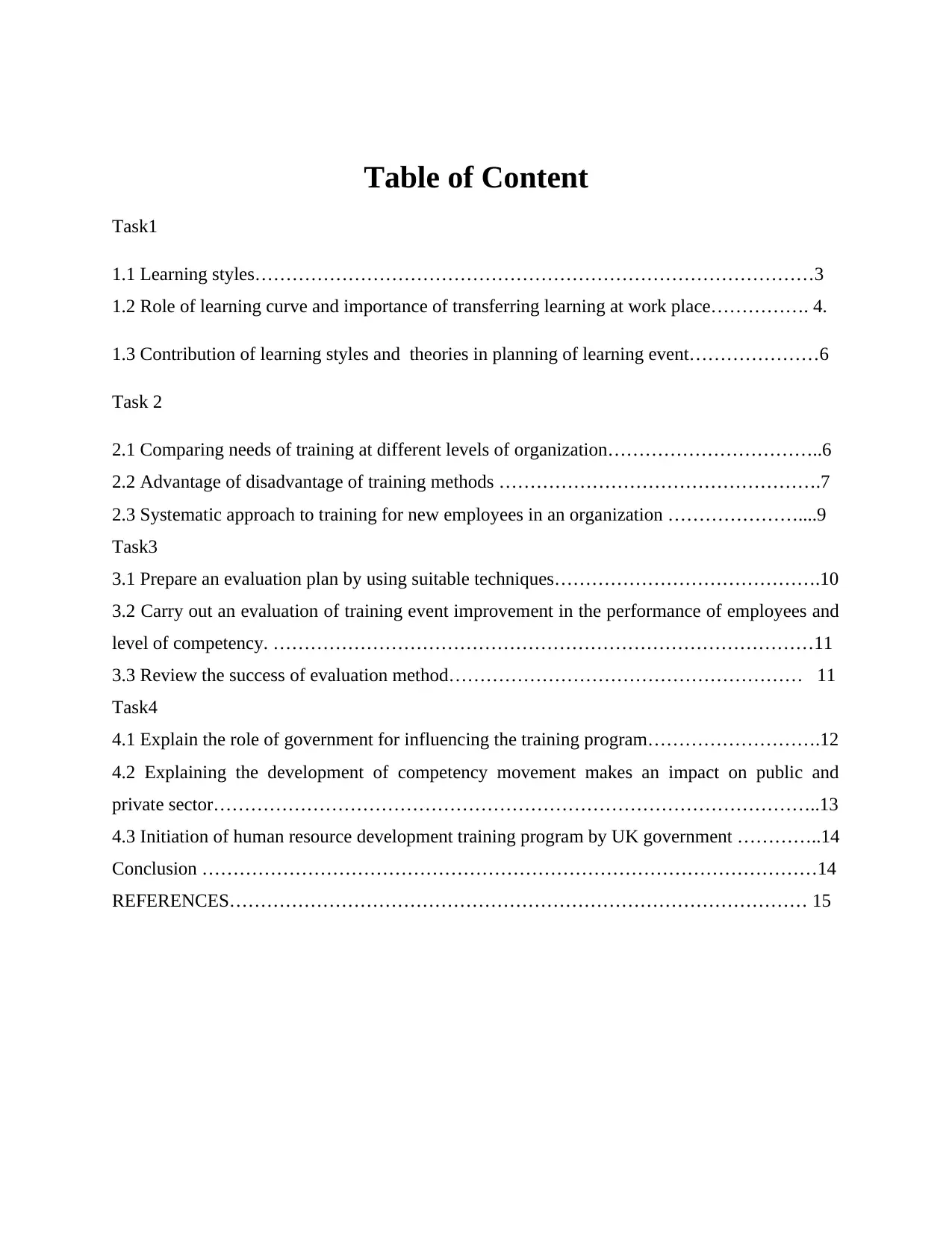
Table of Content
Task1
1.1 Learning styles………………………………………………………………………………3
1.2 Role of learning curve and importance of transferring learning at work place……………. 4.
1.3 Contribution of learning styles and theories in planning of learning event…………………6
Task 2
2.1 Comparing needs of training at different levels of organization……………………………..6
2.2 Advantage of disadvantage of training methods …………………………………………….7
2.3 Systematic approach to training for new employees in an organization …………………....9
Task3
3.1 Prepare an evaluation plan by using suitable techniques…………………………………….10
3.2 Carry out an evaluation of training event improvement in the performance of employees and
level of competency. ……………………………………………………………………………11
3.3 Review the success of evaluation method………………………………………………… 11
Task4
4.1 Explain the role of government for influencing the training program……………………….12
4.2 Explaining the development of competency movement makes an impact on public and
private sector……………………………………………………………………………………..13
4.3 Initiation of human resource development training program by UK government …………..14
Conclusion ………………………………………………………………………………………14
REFERENCES………………………………………………………………………………… 15
Task1
1.1 Learning styles………………………………………………………………………………3
1.2 Role of learning curve and importance of transferring learning at work place……………. 4.
1.3 Contribution of learning styles and theories in planning of learning event…………………6
Task 2
2.1 Comparing needs of training at different levels of organization……………………………..6
2.2 Advantage of disadvantage of training methods …………………………………………….7
2.3 Systematic approach to training for new employees in an organization …………………....9
Task3
3.1 Prepare an evaluation plan by using suitable techniques…………………………………….10
3.2 Carry out an evaluation of training event improvement in the performance of employees and
level of competency. ……………………………………………………………………………11
3.3 Review the success of evaluation method………………………………………………… 11
Task4
4.1 Explain the role of government for influencing the training program……………………….12
4.2 Explaining the development of competency movement makes an impact on public and
private sector……………………………………………………………………………………..13
4.3 Initiation of human resource development training program by UK government …………..14
Conclusion ………………………………………………………………………………………14
REFERENCES………………………………………………………………………………… 15
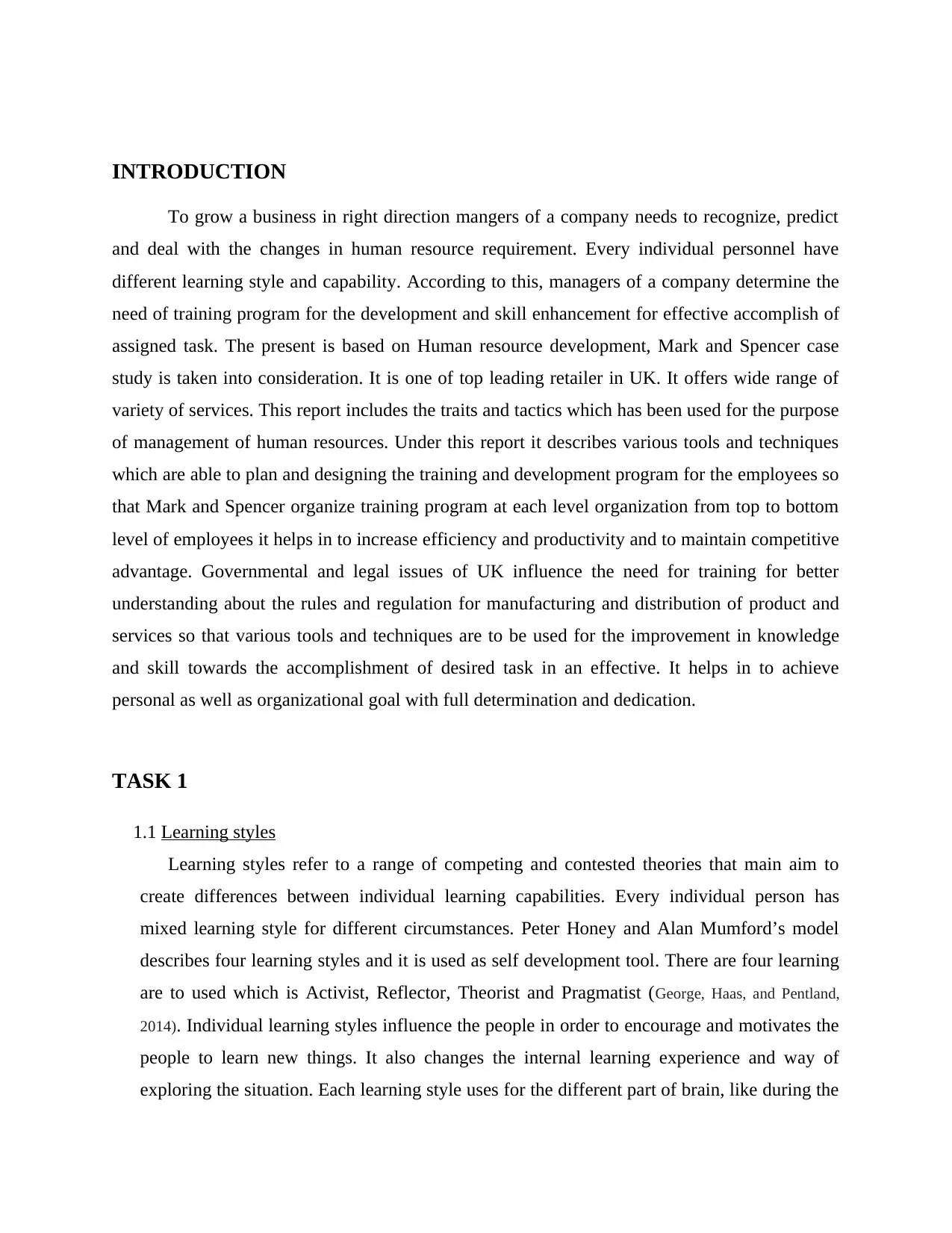
INTRODUCTION
To grow a business in right direction mangers of a company needs to recognize, predict
and deal with the changes in human resource requirement. Every individual personnel have
different learning style and capability. According to this, managers of a company determine the
need of training program for the development and skill enhancement for effective accomplish of
assigned task. The present is based on Human resource development, Mark and Spencer case
study is taken into consideration. It is one of top leading retailer in UK. It offers wide range of
variety of services. This report includes the traits and tactics which has been used for the purpose
of management of human resources. Under this report it describes various tools and techniques
which are able to plan and designing the training and development program for the employees so
that Mark and Spencer organize training program at each level organization from top to bottom
level of employees it helps in to increase efficiency and productivity and to maintain competitive
advantage. Governmental and legal issues of UK influence the need for training for better
understanding about the rules and regulation for manufacturing and distribution of product and
services so that various tools and techniques are to be used for the improvement in knowledge
and skill towards the accomplishment of desired task in an effective. It helps in to achieve
personal as well as organizational goal with full determination and dedication.
TASK 1
1.1 Learning styles
Learning styles refer to a range of competing and contested theories that main aim to
create differences between individual learning capabilities. Every individual person has
mixed learning style for different circumstances. Peter Honey and Alan Mumford’s model
describes four learning styles and it is used as self development tool. There are four learning
are to used which is Activist, Reflector, Theorist and Pragmatist (George, Haas, and Pentland,
2014). Individual learning styles influence the people in order to encourage and motivates the
people to learn new things. It also changes the internal learning experience and way of
exploring the situation. Each learning style uses for the different part of brain, like during the
To grow a business in right direction mangers of a company needs to recognize, predict
and deal with the changes in human resource requirement. Every individual personnel have
different learning style and capability. According to this, managers of a company determine the
need of training program for the development and skill enhancement for effective accomplish of
assigned task. The present is based on Human resource development, Mark and Spencer case
study is taken into consideration. It is one of top leading retailer in UK. It offers wide range of
variety of services. This report includes the traits and tactics which has been used for the purpose
of management of human resources. Under this report it describes various tools and techniques
which are able to plan and designing the training and development program for the employees so
that Mark and Spencer organize training program at each level organization from top to bottom
level of employees it helps in to increase efficiency and productivity and to maintain competitive
advantage. Governmental and legal issues of UK influence the need for training for better
understanding about the rules and regulation for manufacturing and distribution of product and
services so that various tools and techniques are to be used for the improvement in knowledge
and skill towards the accomplishment of desired task in an effective. It helps in to achieve
personal as well as organizational goal with full determination and dedication.
TASK 1
1.1 Learning styles
Learning styles refer to a range of competing and contested theories that main aim to
create differences between individual learning capabilities. Every individual person has
mixed learning style for different circumstances. Peter Honey and Alan Mumford’s model
describes four learning styles and it is used as self development tool. There are four learning
are to used which is Activist, Reflector, Theorist and Pragmatist (George, Haas, and Pentland,
2014). Individual learning styles influence the people in order to encourage and motivates the
people to learn new things. It also changes the internal learning experience and way of
exploring the situation. Each learning style uses for the different part of brain, like during the
⊘ This is a preview!⊘
Do you want full access?
Subscribe today to unlock all pages.

Trusted by 1+ million students worldwide
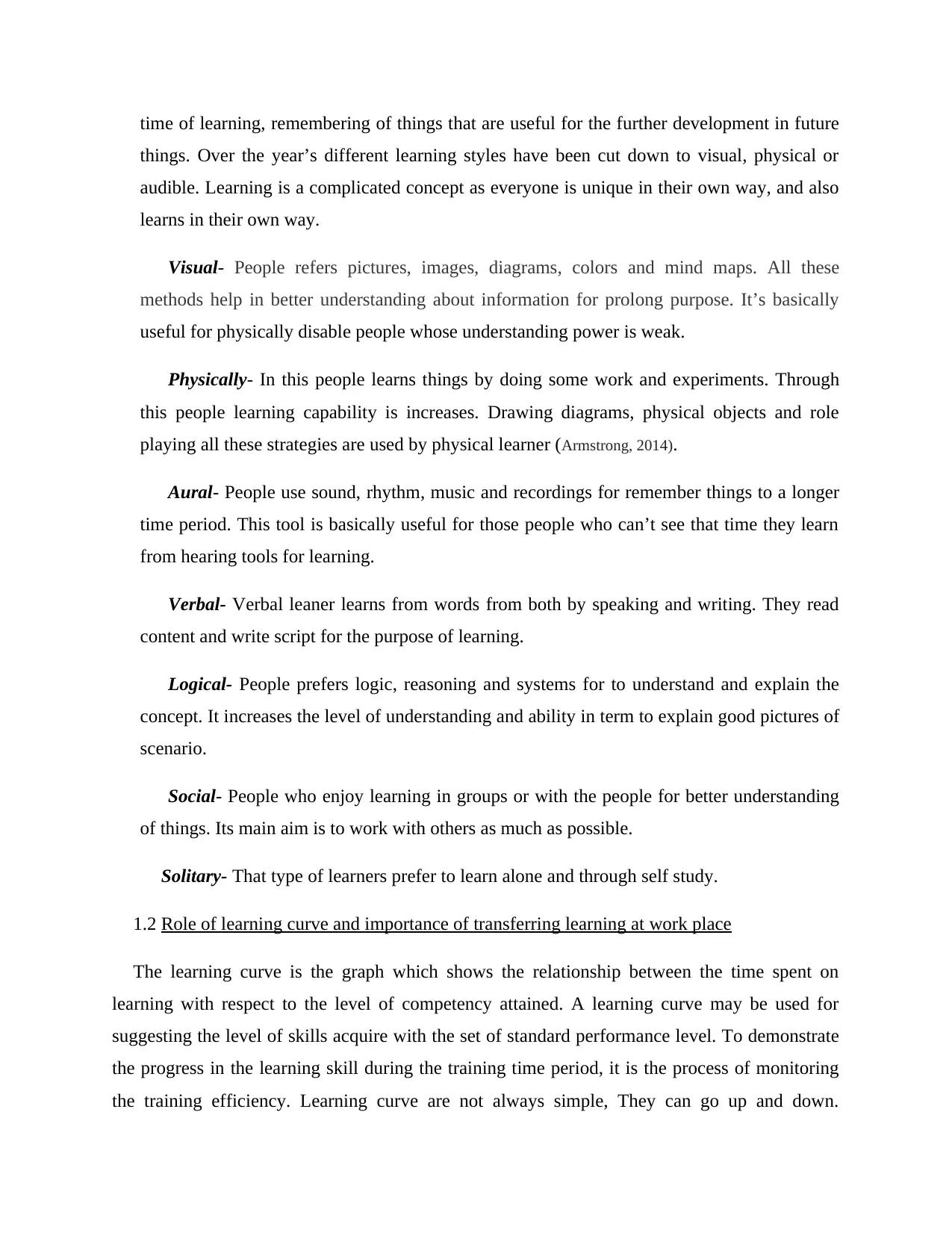
time of learning, remembering of things that are useful for the further development in future
things. Over the year’s different learning styles have been cut down to visual, physical or
audible. Learning is a complicated concept as everyone is unique in their own way, and also
learns in their own way.
Visual- People refers pictures, images, diagrams, colors and mind maps. All these
methods help in better understanding about information for prolong purpose. It’s basically
useful for physically disable people whose understanding power is weak.
Physically- In this people learns things by doing some work and experiments. Through
this people learning capability is increases. Drawing diagrams, physical objects and role
playing all these strategies are used by physical learner (Armstrong, 2014).
Aural- People use sound, rhythm, music and recordings for remember things to a longer
time period. This tool is basically useful for those people who can’t see that time they learn
from hearing tools for learning.
Verbal- Verbal leaner learns from words from both by speaking and writing. They read
content and write script for the purpose of learning.
Logical- People prefers logic, reasoning and systems for to understand and explain the
concept. It increases the level of understanding and ability in term to explain good pictures of
scenario.
Social- People who enjoy learning in groups or with the people for better understanding
of things. Its main aim is to work with others as much as possible.
Solitary- That type of learners prefer to learn alone and through self study.
1.2 Role of learning curve and importance of transferring learning at work place
The learning curve is the graph which shows the relationship between the time spent on
learning with respect to the level of competency attained. A learning curve may be used for
suggesting the level of skills acquire with the set of standard performance level. To demonstrate
the progress in the learning skill during the training time period, it is the process of monitoring
the training efficiency. Learning curve are not always simple, They can go up and down.
things. Over the year’s different learning styles have been cut down to visual, physical or
audible. Learning is a complicated concept as everyone is unique in their own way, and also
learns in their own way.
Visual- People refers pictures, images, diagrams, colors and mind maps. All these
methods help in better understanding about information for prolong purpose. It’s basically
useful for physically disable people whose understanding power is weak.
Physically- In this people learns things by doing some work and experiments. Through
this people learning capability is increases. Drawing diagrams, physical objects and role
playing all these strategies are used by physical learner (Armstrong, 2014).
Aural- People use sound, rhythm, music and recordings for remember things to a longer
time period. This tool is basically useful for those people who can’t see that time they learn
from hearing tools for learning.
Verbal- Verbal leaner learns from words from both by speaking and writing. They read
content and write script for the purpose of learning.
Logical- People prefers logic, reasoning and systems for to understand and explain the
concept. It increases the level of understanding and ability in term to explain good pictures of
scenario.
Social- People who enjoy learning in groups or with the people for better understanding
of things. Its main aim is to work with others as much as possible.
Solitary- That type of learners prefer to learn alone and through self study.
1.2 Role of learning curve and importance of transferring learning at work place
The learning curve is the graph which shows the relationship between the time spent on
learning with respect to the level of competency attained. A learning curve may be used for
suggesting the level of skills acquire with the set of standard performance level. To demonstrate
the progress in the learning skill during the training time period, it is the process of monitoring
the training efficiency. Learning curve are not always simple, They can go up and down.
Paraphrase This Document
Need a fresh take? Get an instant paraphrase of this document with our AI Paraphraser
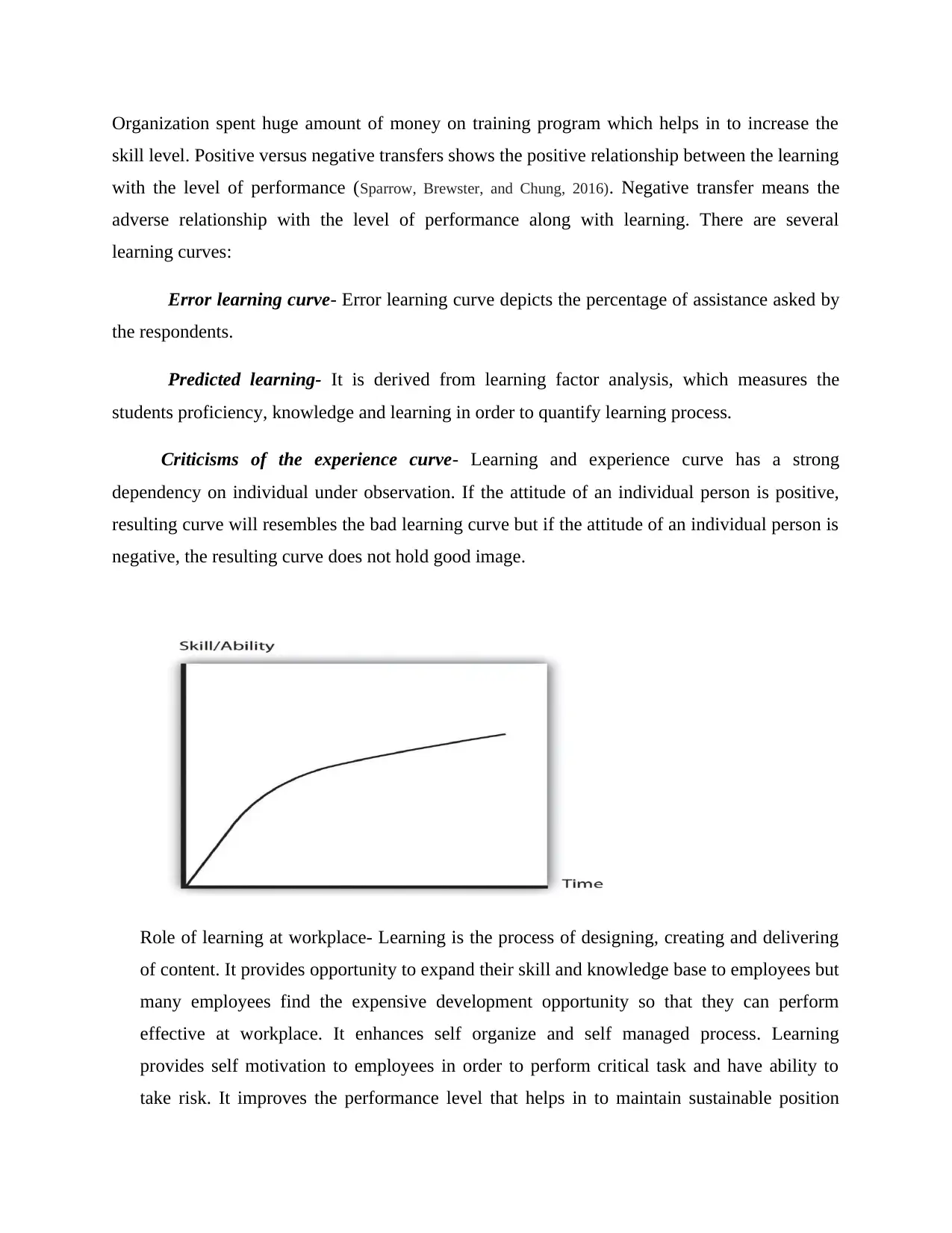
Organization spent huge amount of money on training program which helps in to increase the
skill level. Positive versus negative transfers shows the positive relationship between the learning
with the level of performance (Sparrow, Brewster, and Chung, 2016). Negative transfer means the
adverse relationship with the level of performance along with learning. There are several
learning curves:
Error learning curve- Error learning curve depicts the percentage of assistance asked by
the respondents.
Predicted learning- It is derived from learning factor analysis, which measures the
students proficiency, knowledge and learning in order to quantify learning process.
Criticisms of the experience curve- Learning and experience curve has a strong
dependency on individual under observation. If the attitude of an individual person is positive,
resulting curve will resembles the bad learning curve but if the attitude of an individual person is
negative, the resulting curve does not hold good image.
Role of learning at workplace- Learning is the process of designing, creating and delivering
of content. It provides opportunity to expand their skill and knowledge base to employees but
many employees find the expensive development opportunity so that they can perform
effective at workplace. It enhances self organize and self managed process. Learning
provides self motivation to employees in order to perform critical task and have ability to
take risk. It improves the performance level that helps in to maintain sustainable position
skill level. Positive versus negative transfers shows the positive relationship between the learning
with the level of performance (Sparrow, Brewster, and Chung, 2016). Negative transfer means the
adverse relationship with the level of performance along with learning. There are several
learning curves:
Error learning curve- Error learning curve depicts the percentage of assistance asked by
the respondents.
Predicted learning- It is derived from learning factor analysis, which measures the
students proficiency, knowledge and learning in order to quantify learning process.
Criticisms of the experience curve- Learning and experience curve has a strong
dependency on individual under observation. If the attitude of an individual person is positive,
resulting curve will resembles the bad learning curve but if the attitude of an individual person is
negative, the resulting curve does not hold good image.
Role of learning at workplace- Learning is the process of designing, creating and delivering
of content. It provides opportunity to expand their skill and knowledge base to employees but
many employees find the expensive development opportunity so that they can perform
effective at workplace. It enhances self organize and self managed process. Learning
provides self motivation to employees in order to perform critical task and have ability to
take risk. It improves the performance level that helps in to maintain sustainable position
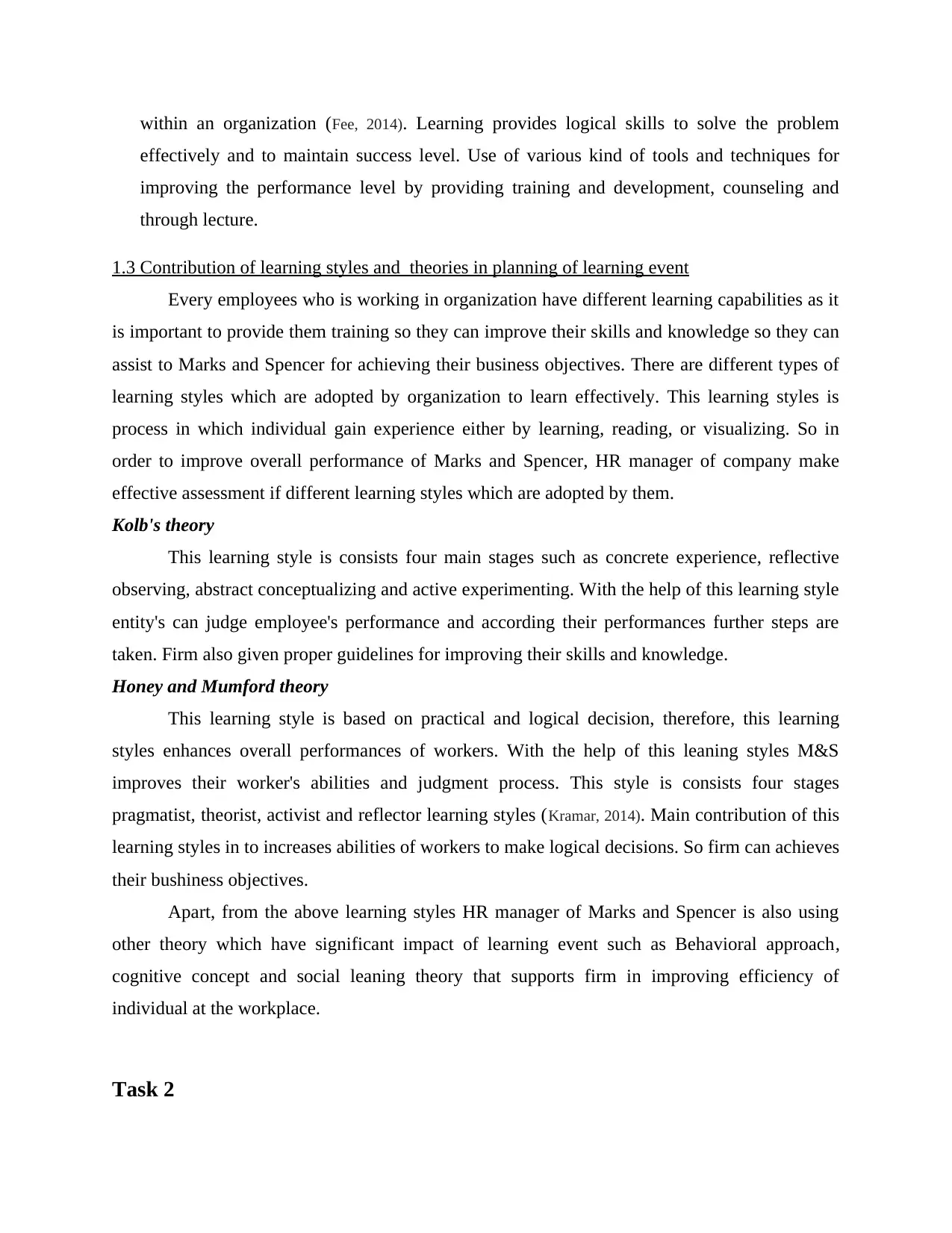
within an organization (Fee, 2014). Learning provides logical skills to solve the problem
effectively and to maintain success level. Use of various kind of tools and techniques for
improving the performance level by providing training and development, counseling and
through lecture.
1.3 Contribution of learning styles and theories in planning of learning event
Every employees who is working in organization have different learning capabilities as it
is important to provide them training so they can improve their skills and knowledge so they can
assist to Marks and Spencer for achieving their business objectives. There are different types of
learning styles which are adopted by organization to learn effectively. This learning styles is
process in which individual gain experience either by learning, reading, or visualizing. So in
order to improve overall performance of Marks and Spencer, HR manager of company make
effective assessment if different learning styles which are adopted by them.
Kolb's theory
This learning style is consists four main stages such as concrete experience, reflective
observing, abstract conceptualizing and active experimenting. With the help of this learning style
entity's can judge employee's performance and according their performances further steps are
taken. Firm also given proper guidelines for improving their skills and knowledge.
Honey and Mumford theory
This learning style is based on practical and logical decision, therefore, this learning
styles enhances overall performances of workers. With the help of this leaning styles M&S
improves their worker's abilities and judgment process. This style is consists four stages
pragmatist, theorist, activist and reflector learning styles (Kramar, 2014). Main contribution of this
learning styles in to increases abilities of workers to make logical decisions. So firm can achieves
their bushiness objectives.
Apart, from the above learning styles HR manager of Marks and Spencer is also using
other theory which have significant impact of learning event such as Behavioral approach,
cognitive concept and social leaning theory that supports firm in improving efficiency of
individual at the workplace.
Task 2
effectively and to maintain success level. Use of various kind of tools and techniques for
improving the performance level by providing training and development, counseling and
through lecture.
1.3 Contribution of learning styles and theories in planning of learning event
Every employees who is working in organization have different learning capabilities as it
is important to provide them training so they can improve their skills and knowledge so they can
assist to Marks and Spencer for achieving their business objectives. There are different types of
learning styles which are adopted by organization to learn effectively. This learning styles is
process in which individual gain experience either by learning, reading, or visualizing. So in
order to improve overall performance of Marks and Spencer, HR manager of company make
effective assessment if different learning styles which are adopted by them.
Kolb's theory
This learning style is consists four main stages such as concrete experience, reflective
observing, abstract conceptualizing and active experimenting. With the help of this learning style
entity's can judge employee's performance and according their performances further steps are
taken. Firm also given proper guidelines for improving their skills and knowledge.
Honey and Mumford theory
This learning style is based on practical and logical decision, therefore, this learning
styles enhances overall performances of workers. With the help of this leaning styles M&S
improves their worker's abilities and judgment process. This style is consists four stages
pragmatist, theorist, activist and reflector learning styles (Kramar, 2014). Main contribution of this
learning styles in to increases abilities of workers to make logical decisions. So firm can achieves
their bushiness objectives.
Apart, from the above learning styles HR manager of Marks and Spencer is also using
other theory which have significant impact of learning event such as Behavioral approach,
cognitive concept and social leaning theory that supports firm in improving efficiency of
individual at the workplace.
Task 2
⊘ This is a preview!⊘
Do you want full access?
Subscribe today to unlock all pages.

Trusted by 1+ million students worldwide
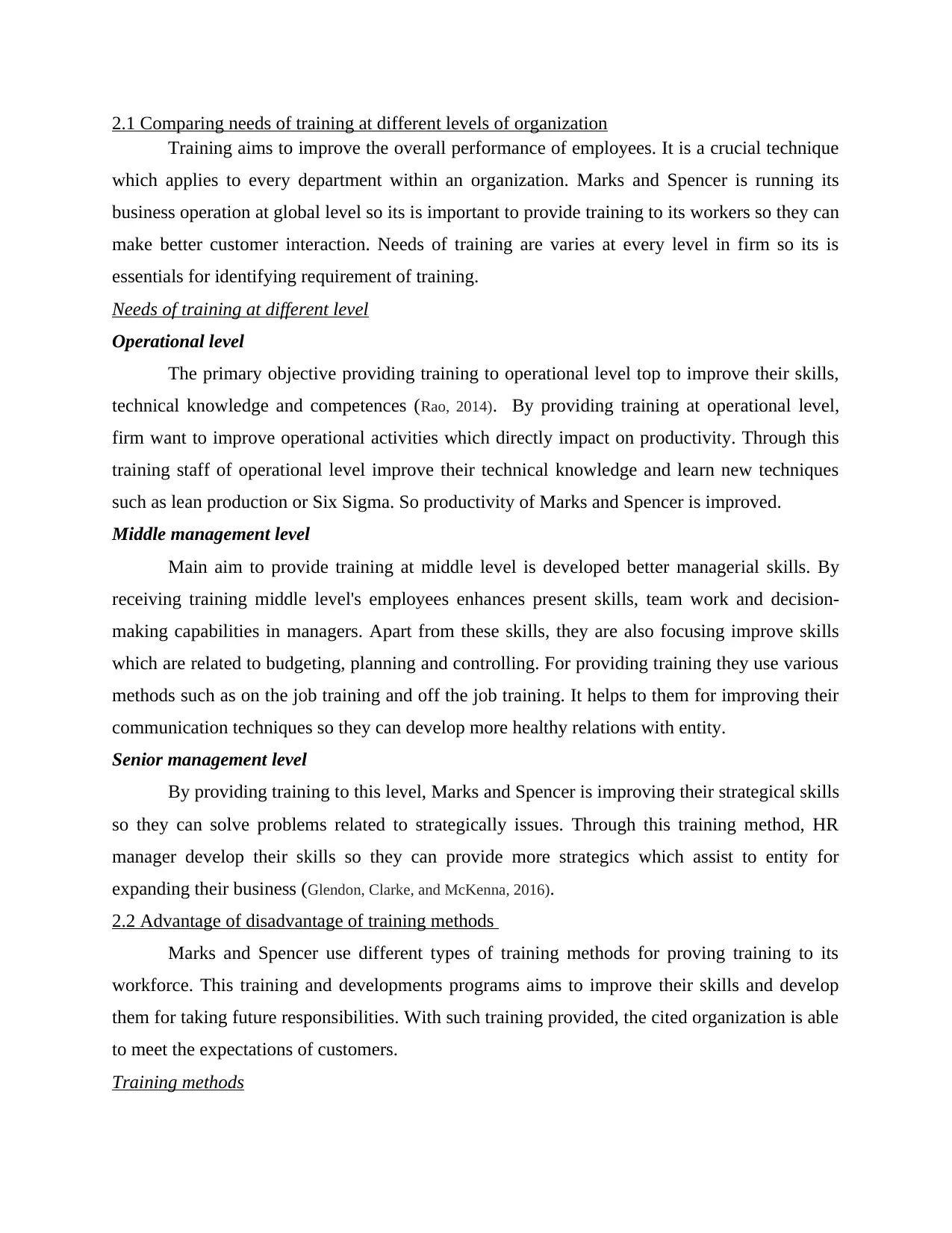
2.1 Comparing needs of training at different levels of organization
Training aims to improve the overall performance of employees. It is a crucial technique
which applies to every department within an organization. Marks and Spencer is running its
business operation at global level so its is important to provide training to its workers so they can
make better customer interaction. Needs of training are varies at every level in firm so its is
essentials for identifying requirement of training.
Needs of training at different level
Operational level
The primary objective providing training to operational level top to improve their skills,
technical knowledge and competences (Rao, 2014). By providing training at operational level,
firm want to improve operational activities which directly impact on productivity. Through this
training staff of operational level improve their technical knowledge and learn new techniques
such as lean production or Six Sigma. So productivity of Marks and Spencer is improved.
Middle management level
Main aim to provide training at middle level is developed better managerial skills. By
receiving training middle level's employees enhances present skills, team work and decision-
making capabilities in managers. Apart from these skills, they are also focusing improve skills
which are related to budgeting, planning and controlling. For providing training they use various
methods such as on the job training and off the job training. It helps to them for improving their
communication techniques so they can develop more healthy relations with entity.
Senior management level
By providing training to this level, Marks and Spencer is improving their strategical skills
so they can solve problems related to strategically issues. Through this training method, HR
manager develop their skills so they can provide more strategics which assist to entity for
expanding their business (Glendon, Clarke, and McKenna, 2016).
2.2 Advantage of disadvantage of training methods
Marks and Spencer use different types of training methods for proving training to its
workforce. This training and developments programs aims to improve their skills and develop
them for taking future responsibilities. With such training provided, the cited organization is able
to meet the expectations of customers.
Training methods
Training aims to improve the overall performance of employees. It is a crucial technique
which applies to every department within an organization. Marks and Spencer is running its
business operation at global level so its is important to provide training to its workers so they can
make better customer interaction. Needs of training are varies at every level in firm so its is
essentials for identifying requirement of training.
Needs of training at different level
Operational level
The primary objective providing training to operational level top to improve their skills,
technical knowledge and competences (Rao, 2014). By providing training at operational level,
firm want to improve operational activities which directly impact on productivity. Through this
training staff of operational level improve their technical knowledge and learn new techniques
such as lean production or Six Sigma. So productivity of Marks and Spencer is improved.
Middle management level
Main aim to provide training at middle level is developed better managerial skills. By
receiving training middle level's employees enhances present skills, team work and decision-
making capabilities in managers. Apart from these skills, they are also focusing improve skills
which are related to budgeting, planning and controlling. For providing training they use various
methods such as on the job training and off the job training. It helps to them for improving their
communication techniques so they can develop more healthy relations with entity.
Senior management level
By providing training to this level, Marks and Spencer is improving their strategical skills
so they can solve problems related to strategically issues. Through this training method, HR
manager develop their skills so they can provide more strategics which assist to entity for
expanding their business (Glendon, Clarke, and McKenna, 2016).
2.2 Advantage of disadvantage of training methods
Marks and Spencer use different types of training methods for proving training to its
workforce. This training and developments programs aims to improve their skills and develop
them for taking future responsibilities. With such training provided, the cited organization is able
to meet the expectations of customers.
Training methods
Paraphrase This Document
Need a fresh take? Get an instant paraphrase of this document with our AI Paraphraser
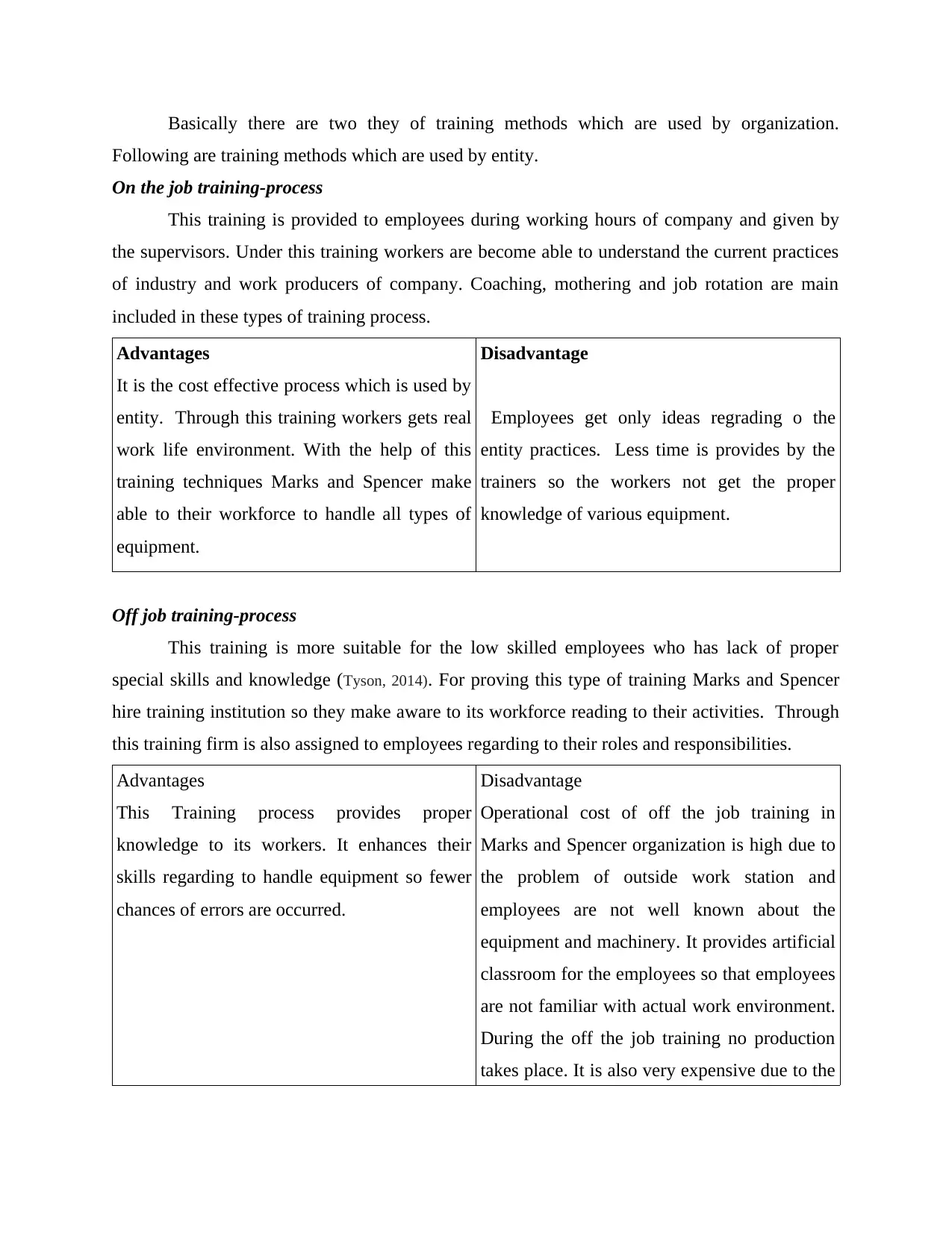
Basically there are two they of training methods which are used by organization.
Following are training methods which are used by entity.
On the job training-process
This training is provided to employees during working hours of company and given by
the supervisors. Under this training workers are become able to understand the current practices
of industry and work producers of company. Coaching, mothering and job rotation are main
included in these types of training process.
Advantages
It is the cost effective process which is used by
entity. Through this training workers gets real
work life environment. With the help of this
training techniques Marks and Spencer make
able to their workforce to handle all types of
equipment.
Disadvantage
Employees get only ideas regrading o the
entity practices. Less time is provides by the
trainers so the workers not get the proper
knowledge of various equipment.
Off job training-process
This training is more suitable for the low skilled employees who has lack of proper
special skills and knowledge (Tyson, 2014). For proving this type of training Marks and Spencer
hire training institution so they make aware to its workforce reading to their activities. Through
this training firm is also assigned to employees regarding to their roles and responsibilities.
Advantages
This Training process provides proper
knowledge to its workers. It enhances their
skills regarding to handle equipment so fewer
chances of errors are occurred.
Disadvantage
Operational cost of off the job training in
Marks and Spencer organization is high due to
the problem of outside work station and
employees are not well known about the
equipment and machinery. It provides artificial
classroom for the employees so that employees
are not familiar with actual work environment.
During the off the job training no production
takes place. It is also very expensive due to the
Following are training methods which are used by entity.
On the job training-process
This training is provided to employees during working hours of company and given by
the supervisors. Under this training workers are become able to understand the current practices
of industry and work producers of company. Coaching, mothering and job rotation are main
included in these types of training process.
Advantages
It is the cost effective process which is used by
entity. Through this training workers gets real
work life environment. With the help of this
training techniques Marks and Spencer make
able to their workforce to handle all types of
equipment.
Disadvantage
Employees get only ideas regrading o the
entity practices. Less time is provides by the
trainers so the workers not get the proper
knowledge of various equipment.
Off job training-process
This training is more suitable for the low skilled employees who has lack of proper
special skills and knowledge (Tyson, 2014). For proving this type of training Marks and Spencer
hire training institution so they make aware to its workforce reading to their activities. Through
this training firm is also assigned to employees regarding to their roles and responsibilities.
Advantages
This Training process provides proper
knowledge to its workers. It enhances their
skills regarding to handle equipment so fewer
chances of errors are occurred.
Disadvantage
Operational cost of off the job training in
Marks and Spencer organization is high due to
the problem of outside work station and
employees are not well known about the
equipment and machinery. It provides artificial
classroom for the employees so that employees
are not familiar with actual work environment.
During the off the job training no production
takes place. It is also very expensive due to the
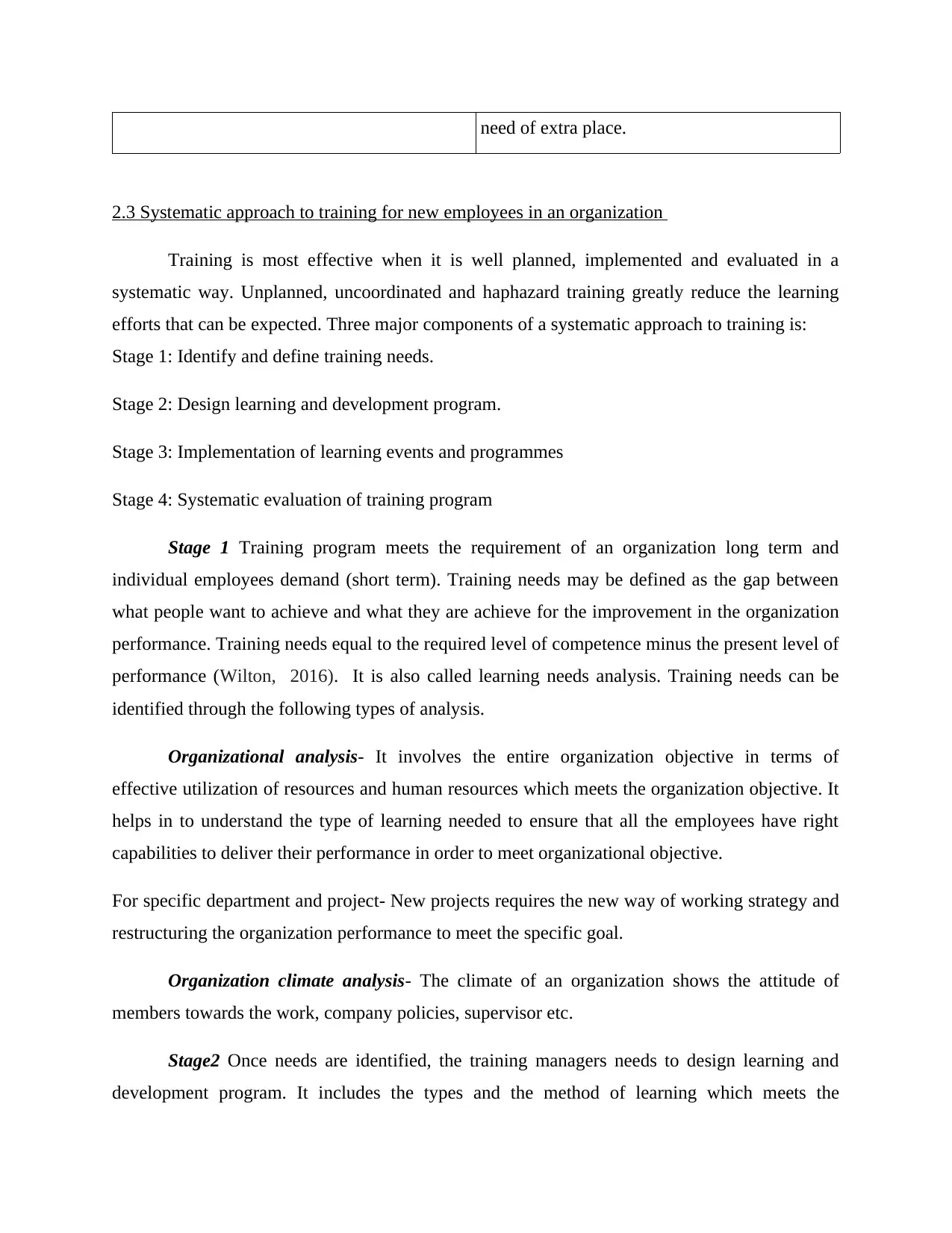
need of extra place.
2.3 Systematic approach to training for new employees in an organization
Training is most effective when it is well planned, implemented and evaluated in a
systematic way. Unplanned, uncoordinated and haphazard training greatly reduce the learning
efforts that can be expected. Three major components of a systematic approach to training is:
Stage 1: Identify and define training needs.
Stage 2: Design learning and development program.
Stage 3: Implementation of learning events and programmes
Stage 4: Systematic evaluation of training program
Stage 1 Training program meets the requirement of an organization long term and
individual employees demand (short term). Training needs may be defined as the gap between
what people want to achieve and what they are achieve for the improvement in the organization
performance. Training needs equal to the required level of competence minus the present level of
performance (Wilton, 2016). It is also called learning needs analysis. Training needs can be
identified through the following types of analysis.
Organizational analysis- It involves the entire organization objective in terms of
effective utilization of resources and human resources which meets the organization objective. It
helps in to understand the type of learning needed to ensure that all the employees have right
capabilities to deliver their performance in order to meet organizational objective.
For specific department and project- New projects requires the new way of working strategy and
restructuring the organization performance to meet the specific goal.
Organization climate analysis- The climate of an organization shows the attitude of
members towards the work, company policies, supervisor etc.
Stage2 Once needs are identified, the training managers needs to design learning and
development program. It includes the types and the method of learning which meets the
2.3 Systematic approach to training for new employees in an organization
Training is most effective when it is well planned, implemented and evaluated in a
systematic way. Unplanned, uncoordinated and haphazard training greatly reduce the learning
efforts that can be expected. Three major components of a systematic approach to training is:
Stage 1: Identify and define training needs.
Stage 2: Design learning and development program.
Stage 3: Implementation of learning events and programmes
Stage 4: Systematic evaluation of training program
Stage 1 Training program meets the requirement of an organization long term and
individual employees demand (short term). Training needs may be defined as the gap between
what people want to achieve and what they are achieve for the improvement in the organization
performance. Training needs equal to the required level of competence minus the present level of
performance (Wilton, 2016). It is also called learning needs analysis. Training needs can be
identified through the following types of analysis.
Organizational analysis- It involves the entire organization objective in terms of
effective utilization of resources and human resources which meets the organization objective. It
helps in to understand the type of learning needed to ensure that all the employees have right
capabilities to deliver their performance in order to meet organizational objective.
For specific department and project- New projects requires the new way of working strategy and
restructuring the organization performance to meet the specific goal.
Organization climate analysis- The climate of an organization shows the attitude of
members towards the work, company policies, supervisor etc.
Stage2 Once needs are identified, the training managers needs to design learning and
development program. It includes the types and the method of learning which meets the
⊘ This is a preview!⊘
Do you want full access?
Subscribe today to unlock all pages.

Trusted by 1+ million students worldwide
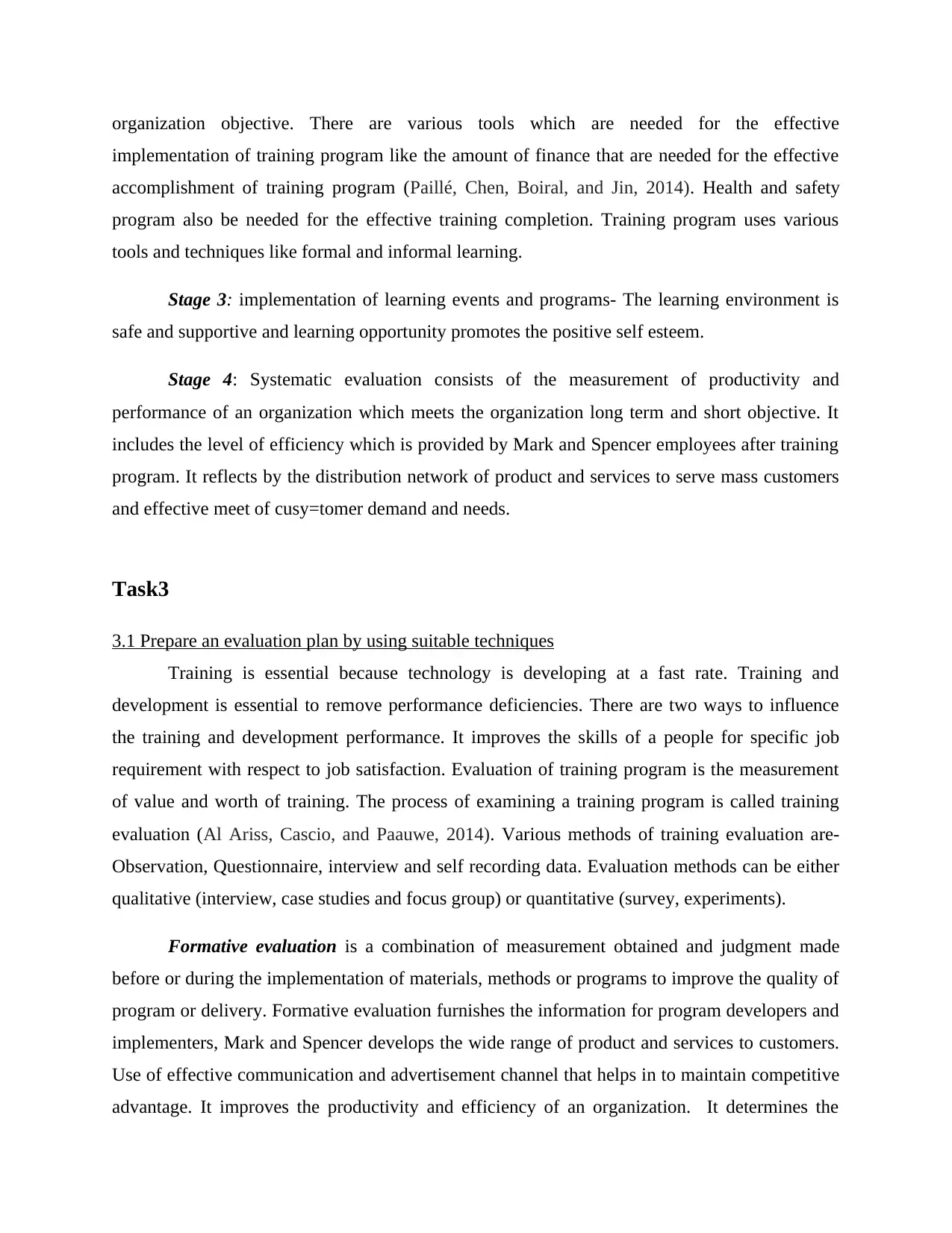
organization objective. There are various tools which are needed for the effective
implementation of training program like the amount of finance that are needed for the effective
accomplishment of training program (Paillé, Chen, Boiral, and Jin, 2014). Health and safety
program also be needed for the effective training completion. Training program uses various
tools and techniques like formal and informal learning.
Stage 3: implementation of learning events and programs- The learning environment is
safe and supportive and learning opportunity promotes the positive self esteem.
Stage 4: Systematic evaluation consists of the measurement of productivity and
performance of an organization which meets the organization long term and short objective. It
includes the level of efficiency which is provided by Mark and Spencer employees after training
program. It reflects by the distribution network of product and services to serve mass customers
and effective meet of cusy=tomer demand and needs.
Task3
3.1 Prepare an evaluation plan by using suitable techniques
Training is essential because technology is developing at a fast rate. Training and
development is essential to remove performance deficiencies. There are two ways to influence
the training and development performance. It improves the skills of a people for specific job
requirement with respect to job satisfaction. Evaluation of training program is the measurement
of value and worth of training. The process of examining a training program is called training
evaluation (Al Ariss, Cascio, and Paauwe, 2014). Various methods of training evaluation are-
Observation, Questionnaire, interview and self recording data. Evaluation methods can be either
qualitative (interview, case studies and focus group) or quantitative (survey, experiments).
Formative evaluation is a combination of measurement obtained and judgment made
before or during the implementation of materials, methods or programs to improve the quality of
program or delivery. Formative evaluation furnishes the information for program developers and
implementers, Mark and Spencer develops the wide range of product and services to customers.
Use of effective communication and advertisement channel that helps in to maintain competitive
advantage. It improves the productivity and efficiency of an organization. It determines the
implementation of training program like the amount of finance that are needed for the effective
accomplishment of training program (Paillé, Chen, Boiral, and Jin, 2014). Health and safety
program also be needed for the effective training completion. Training program uses various
tools and techniques like formal and informal learning.
Stage 3: implementation of learning events and programs- The learning environment is
safe and supportive and learning opportunity promotes the positive self esteem.
Stage 4: Systematic evaluation consists of the measurement of productivity and
performance of an organization which meets the organization long term and short objective. It
includes the level of efficiency which is provided by Mark and Spencer employees after training
program. It reflects by the distribution network of product and services to serve mass customers
and effective meet of cusy=tomer demand and needs.
Task3
3.1 Prepare an evaluation plan by using suitable techniques
Training is essential because technology is developing at a fast rate. Training and
development is essential to remove performance deficiencies. There are two ways to influence
the training and development performance. It improves the skills of a people for specific job
requirement with respect to job satisfaction. Evaluation of training program is the measurement
of value and worth of training. The process of examining a training program is called training
evaluation (Al Ariss, Cascio, and Paauwe, 2014). Various methods of training evaluation are-
Observation, Questionnaire, interview and self recording data. Evaluation methods can be either
qualitative (interview, case studies and focus group) or quantitative (survey, experiments).
Formative evaluation is a combination of measurement obtained and judgment made
before or during the implementation of materials, methods or programs to improve the quality of
program or delivery. Formative evaluation furnishes the information for program developers and
implementers, Mark and Spencer develops the wide range of product and services to customers.
Use of effective communication and advertisement channel that helps in to maintain competitive
advantage. It improves the productivity and efficiency of an organization. It determines the
Paraphrase This Document
Need a fresh take? Get an instant paraphrase of this document with our AI Paraphraser
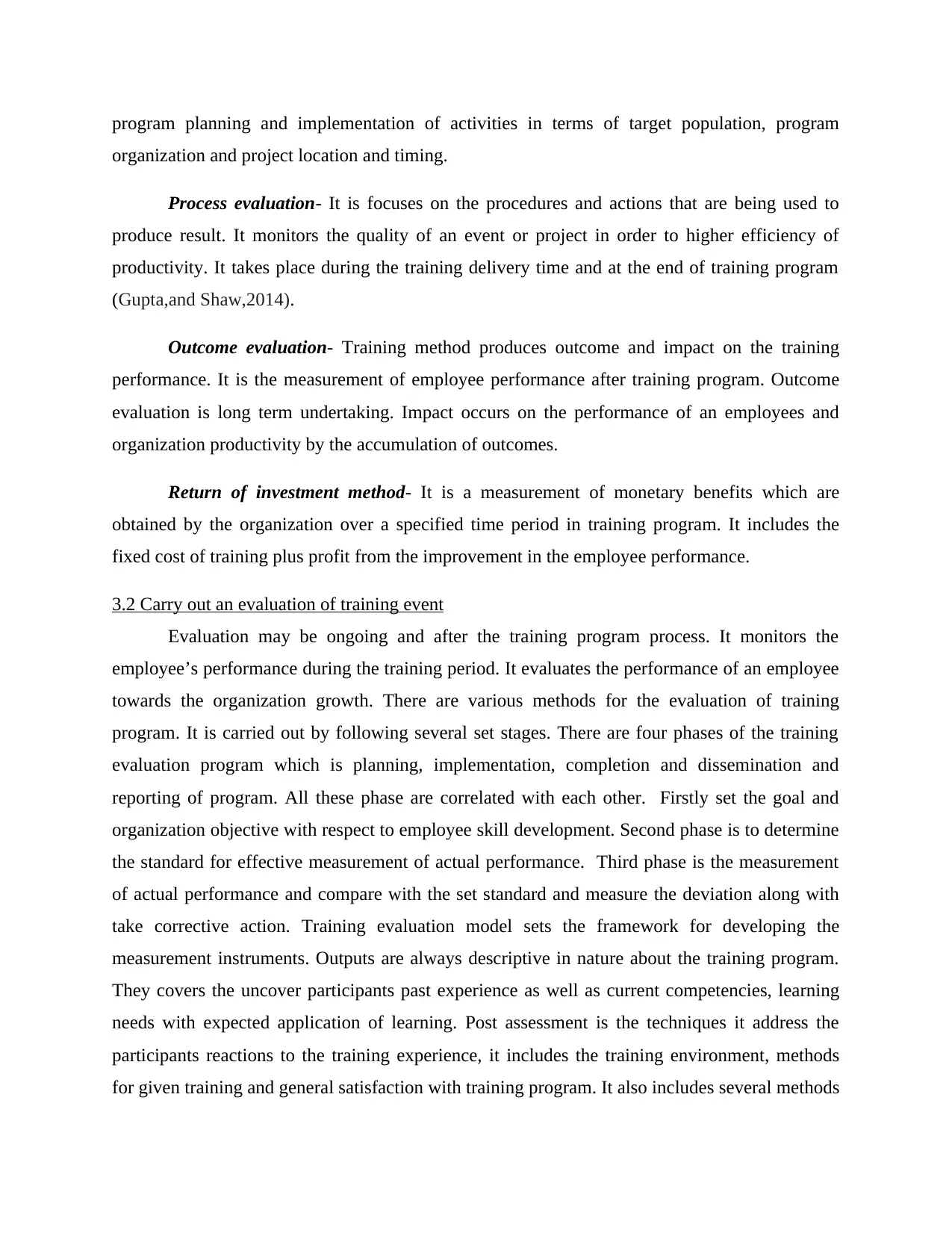
program planning and implementation of activities in terms of target population, program
organization and project location and timing.
Process evaluation- It is focuses on the procedures and actions that are being used to
produce result. It monitors the quality of an event or project in order to higher efficiency of
productivity. It takes place during the training delivery time and at the end of training program
(Gupta,and Shaw,2014).
Outcome evaluation- Training method produces outcome and impact on the training
performance. It is the measurement of employee performance after training program. Outcome
evaluation is long term undertaking. Impact occurs on the performance of an employees and
organization productivity by the accumulation of outcomes.
Return of investment method- It is a measurement of monetary benefits which are
obtained by the organization over a specified time period in training program. It includes the
fixed cost of training plus profit from the improvement in the employee performance.
3.2 Carry out an evaluation of training event
Evaluation may be ongoing and after the training program process. It monitors the
employee’s performance during the training period. It evaluates the performance of an employee
towards the organization growth. There are various methods for the evaluation of training
program. It is carried out by following several set stages. There are four phases of the training
evaluation program which is planning, implementation, completion and dissemination and
reporting of program. All these phase are correlated with each other. Firstly set the goal and
organization objective with respect to employee skill development. Second phase is to determine
the standard for effective measurement of actual performance. Third phase is the measurement
of actual performance and compare with the set standard and measure the deviation along with
take corrective action. Training evaluation model sets the framework for developing the
measurement instruments. Outputs are always descriptive in nature about the training program.
They covers the uncover participants past experience as well as current competencies, learning
needs with expected application of learning. Post assessment is the techniques it address the
participants reactions to the training experience, it includes the training environment, methods
for given training and general satisfaction with training program. It also includes several methods
organization and project location and timing.
Process evaluation- It is focuses on the procedures and actions that are being used to
produce result. It monitors the quality of an event or project in order to higher efficiency of
productivity. It takes place during the training delivery time and at the end of training program
(Gupta,and Shaw,2014).
Outcome evaluation- Training method produces outcome and impact on the training
performance. It is the measurement of employee performance after training program. Outcome
evaluation is long term undertaking. Impact occurs on the performance of an employees and
organization productivity by the accumulation of outcomes.
Return of investment method- It is a measurement of monetary benefits which are
obtained by the organization over a specified time period in training program. It includes the
fixed cost of training plus profit from the improvement in the employee performance.
3.2 Carry out an evaluation of training event
Evaluation may be ongoing and after the training program process. It monitors the
employee’s performance during the training period. It evaluates the performance of an employee
towards the organization growth. There are various methods for the evaluation of training
program. It is carried out by following several set stages. There are four phases of the training
evaluation program which is planning, implementation, completion and dissemination and
reporting of program. All these phase are correlated with each other. Firstly set the goal and
organization objective with respect to employee skill development. Second phase is to determine
the standard for effective measurement of actual performance. Third phase is the measurement
of actual performance and compare with the set standard and measure the deviation along with
take corrective action. Training evaluation model sets the framework for developing the
measurement instruments. Outputs are always descriptive in nature about the training program.
They covers the uncover participants past experience as well as current competencies, learning
needs with expected application of learning. Post assessment is the techniques it address the
participants reactions to the training experience, it includes the training environment, methods
for given training and general satisfaction with training program. It also includes several methods
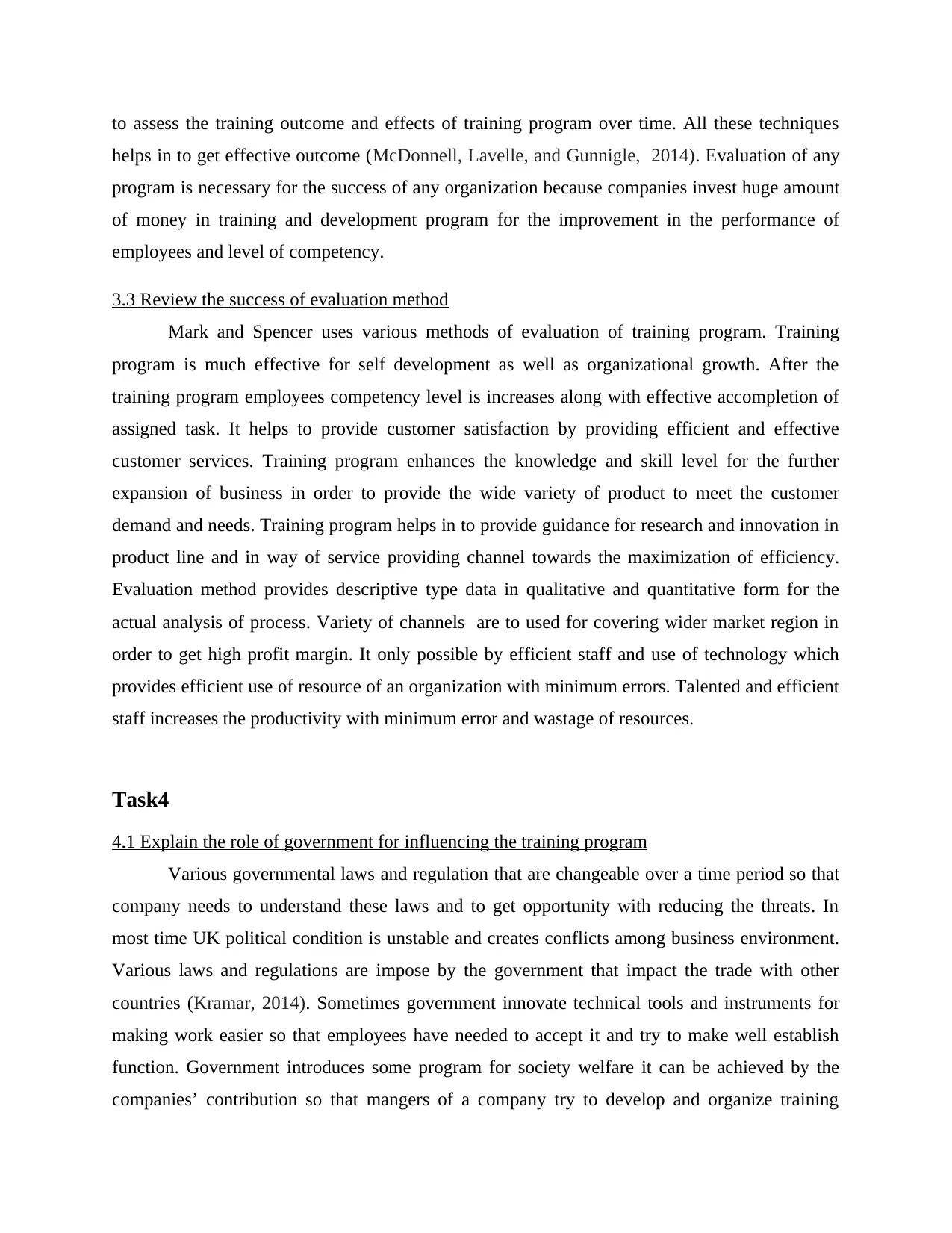
to assess the training outcome and effects of training program over time. All these techniques
helps in to get effective outcome (McDonnell, Lavelle, and Gunnigle, 2014). Evaluation of any
program is necessary for the success of any organization because companies invest huge amount
of money in training and development program for the improvement in the performance of
employees and level of competency.
3.3 Review the success of evaluation method
Mark and Spencer uses various methods of evaluation of training program. Training
program is much effective for self development as well as organizational growth. After the
training program employees competency level is increases along with effective accompletion of
assigned task. It helps to provide customer satisfaction by providing efficient and effective
customer services. Training program enhances the knowledge and skill level for the further
expansion of business in order to provide the wide variety of product to meet the customer
demand and needs. Training program helps in to provide guidance for research and innovation in
product line and in way of service providing channel towards the maximization of efficiency.
Evaluation method provides descriptive type data in qualitative and quantitative form for the
actual analysis of process. Variety of channels are to used for covering wider market region in
order to get high profit margin. It only possible by efficient staff and use of technology which
provides efficient use of resource of an organization with minimum errors. Talented and efficient
staff increases the productivity with minimum error and wastage of resources.
Task4
4.1 Explain the role of government for influencing the training program
Various governmental laws and regulation that are changeable over a time period so that
company needs to understand these laws and to get opportunity with reducing the threats. In
most time UK political condition is unstable and creates conflicts among business environment.
Various laws and regulations are impose by the government that impact the trade with other
countries (Kramar, 2014). Sometimes government innovate technical tools and instruments for
making work easier so that employees have needed to accept it and try to make well establish
function. Government introduces some program for society welfare it can be achieved by the
companies’ contribution so that mangers of a company try to develop and organize training
helps in to get effective outcome (McDonnell, Lavelle, and Gunnigle, 2014). Evaluation of any
program is necessary for the success of any organization because companies invest huge amount
of money in training and development program for the improvement in the performance of
employees and level of competency.
3.3 Review the success of evaluation method
Mark and Spencer uses various methods of evaluation of training program. Training
program is much effective for self development as well as organizational growth. After the
training program employees competency level is increases along with effective accompletion of
assigned task. It helps to provide customer satisfaction by providing efficient and effective
customer services. Training program enhances the knowledge and skill level for the further
expansion of business in order to provide the wide variety of product to meet the customer
demand and needs. Training program helps in to provide guidance for research and innovation in
product line and in way of service providing channel towards the maximization of efficiency.
Evaluation method provides descriptive type data in qualitative and quantitative form for the
actual analysis of process. Variety of channels are to used for covering wider market region in
order to get high profit margin. It only possible by efficient staff and use of technology which
provides efficient use of resource of an organization with minimum errors. Talented and efficient
staff increases the productivity with minimum error and wastage of resources.
Task4
4.1 Explain the role of government for influencing the training program
Various governmental laws and regulation that are changeable over a time period so that
company needs to understand these laws and to get opportunity with reducing the threats. In
most time UK political condition is unstable and creates conflicts among business environment.
Various laws and regulations are impose by the government that impact the trade with other
countries (Kramar, 2014). Sometimes government innovate technical tools and instruments for
making work easier so that employees have needed to accept it and try to make well establish
function. Government introduces some program for society welfare it can be achieved by the
companies’ contribution so that mangers of a company try to develop and organize training
⊘ This is a preview!⊘
Do you want full access?
Subscribe today to unlock all pages.

Trusted by 1+ million students worldwide
1 out of 17
Related Documents
Your All-in-One AI-Powered Toolkit for Academic Success.
+13062052269
info@desklib.com
Available 24*7 on WhatsApp / Email
![[object Object]](/_next/static/media/star-bottom.7253800d.svg)
Unlock your academic potential
Copyright © 2020–2025 A2Z Services. All Rights Reserved. Developed and managed by ZUCOL.





